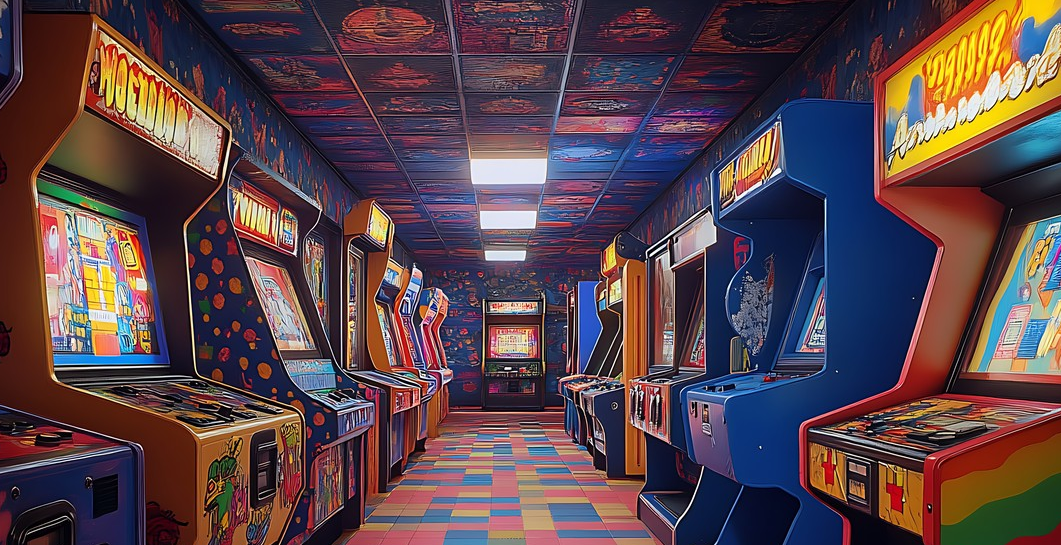Arcades have evolved over the years, transforming from simple gaming spots into multifaceted entertainment hubs. As they adapt to modern trends and technologies, many wonder: how do arcades make money? This article explores the various business models and revenue streams that contribute to the profitability of arcade centers today.
Key Takeaways
- Arcades primarily earn money through the pay-per-play model, where customers pay for each game they play.
- Incorporating redemption games encourages players to return, as they can win prizes, boosting overall revenue.
- Food and beverage sales can significantly enhance profits, often accounting for a large portion of total income.
- Membership and subscription models provide steady income by offering perks to loyal customers.
- Hosting events and parties creates additional revenue streams, making arcades versatile venues.
What Makes Arcades Profitable Today?

Arcades are making a comeback, and their profitability is on the rise. This resurgence is due to a mix of nostalgia and modern gaming trends that attract a wide range of customers. Today’s arcades are not just about playing games; they offer a social experience that brings people together. The blend of classic games and new technology keeps the excitement alive, making them appealing to both older and younger generations.
The financial success of arcades can be attributed to various factors. For instance, many arcades have adopted innovative business models that include not just gaming but also food and drink sales, event hosting, and merchandise. This diversification helps them reach more customers and increase their revenue streams.
To illustrate, let’s look at some average revenue figures for successful arcade centers:
| Location Type | Average Annual Revenue |
|---|---|
| Malls | $500,000 |
| Standalone Locations | $1,000,000 |
| Entertainment Complexes | $750,000 |
As you can see, the location plays a significant role in determining how much money an arcade can make. The more foot traffic an arcade gets, the better its chances of success. Additionally, the variety of games offered, from retro classics to the latest virtual reality experiences, keeps customers coming back for more. Overall, the combination of nostalgia, social interaction, and modern gaming technology makes arcades a profitable venture today.
1. Traditional Coin-Operated Model

The traditional coin-operated model has been a staple in arcades since their inception. This model allows players to insert coins, usually quarters, to play games. In fact, during the golden age of arcade video games, the U.S. arcade video game industry’s revenue generated from quarters tripled to $2.8 billion in 1980. This model is straightforward to understand, making it appealing to a wide range of customers. However, as technology advances, arcade owners face the challenge of keeping their machines updated to attract players.
The revenue from this model can fluctuate based on several factors, including the popularity of the games and the overall foot traffic in the arcade. For instance, a well-placed game that resonates with current trends can significantly boost earnings. On the other hand, outdated machines may lead to a decline in interest and revenue.
To illustrate the impact of the coin-operated model, consider the following table:
| Year | Revenue (in billions) |
|---|---|
| 1980 | 2.8 |
| 1990 | 1.5 |
| 2000 | 0.5 |
| 2020 | 0.2 |
As seen in the table, the revenue from traditional coin-operated games has decreased over the years, highlighting the need for arcade centers to innovate and adapt to changing consumer preferences. Despite these challenges, the coin-operated model remains a fundamental aspect of arcade operations, providing a nostalgic experience for many players while also serving as a primary revenue source.
2. Token and Card Systems

In today’s arcades, token and card systems have become a popular way to enhance the gaming experience. Instead of using coins, players can purchase tokens or load money onto a card, making it easier to play multiple games without fumbling for change. This system not only streamlines the process but also encourages players to spend more.
The convenience of these systems can lead to increased revenue. For instance, when players use cards, they often load more money than they would typically spend in coins. This can significantly boost the arcade’s earnings. According to industry data, arcades that have adopted token and card systems report an increase in customer spending by up to 30% compared to traditional coin-operated machines.
Moreover, these systems can be integrated with loyalty programs, allowing players to earn rewards for their spending. This not only keeps customers coming back but also enhances their overall experience. By offering a seamless way to play, arcades can create a more engaging environment that encourages repeat visits.
In summary, the shift to token and card systems represents a modern approach to arcade gaming, making it easier and more enjoyable for players while also driving revenue for arcade owners. This model is a key factor in understanding how to start your own arcade business.
3. Time-Based Access

Time-based access is a growing trend in arcades, allowing customers to pay for a set amount of time to enjoy games rather than paying per game. This model can lead to increased customer satisfaction as players can explore various games without worrying about individual costs. For instance, an arcade might offer a one-hour pass for $10, encouraging longer visits and more gameplay.
This approach not only attracts more customers but also helps arcades manage their revenue more effectively. By offering different time slots, such as peak and off-peak hours, arcades can optimize their earnings. For example, during busy weekends, they might charge a higher rate compared to quieter weekdays.
Here’s a simple breakdown of how time-based access can work:
| Time Slot | Price | Potential Revenue |
|---|---|---|
| Weekday (1 hour) | $8 | $800 (100 customers) |
| Weekend (1 hour) | $12 | $1200 (100 customers) |
As seen in the table, adjusting prices based on demand can significantly impact overall revenue. This model also encourages players to try out various games, including the top 6 fun arcade games to boost your revenue, which can lead to higher engagement and repeat visits. By focusing on time-based access, arcades can create a more enjoyable experience while maximizing their profits.
4. Membership and Subscription Models

In the ever-evolving landscape of arcades, membership and subscription models have emerged as innovative ways to boost revenue. These models allow customers to pay a set fee for access to games and facilities over a specific period. This approach not only encourages repeat visits but also fosters a sense of community among members.
For instance, some arcades offer monthly subscriptions that provide unlimited access to games, exclusive events, and discounts on food and beverages. This model can lead to a steady stream of income, as members are more likely to visit frequently to get their money’s worth.
To illustrate the potential impact of these models, consider the following table:
| Model Type | Monthly Fee | Estimated Monthly Revenue (100 Members) |
|---|---|---|
| Basic Membership | $20 | $2,000 |
| Premium Membership | $40 | $4,000 |
As shown, even a modest number of members can significantly contribute to an arcade’s bottom line. Additionally, these models can help arcades adapt to changing consumer preferences, as they can easily adjust membership benefits based on feedback and trends.
5. Redemption and Prize Games

Redemption and prize games are a key part of what makes arcades fun and profitable. These games allow players to earn tickets based on their performance, which they can then exchange for prizes. This system not only encourages players to keep coming back but also adds an exciting element to the gaming experience.
The success of these games often hinges on having attractive prizes that appeal to a wide audience. For example, popular ticket redemption game machines like “Lucky Monopoly” have become favorites among players, blending skill and luck to create memorable experiences.
To illustrate the impact of redemption games, consider the following table:
| Revenue Contribution | Percentage |
|---|---|
| Redemption Games | 20% – 30% |
| Other Games | 70% – 80% |
By effectively managing the costs associated with prizes, arcades can maintain a healthy profit margin while keeping players engaged. The thrill of winning tickets and the anticipation of redeeming them for prizes is a significant draw for many arcade-goers, making redemption games a vital revenue stream for arcade centers.
6. Food and Beverage Sales

When you think of arcades, you might picture flashing lights and the sounds of games, but food and beverage sales play a huge role in their success. Many arcades have started to offer a variety of snacks and drinks, turning them into social spots where friends can hang out and enjoy themselves. This not only keeps customers happy but also encourages them to stay longer, which can lead to more game plays.
In fact, studies show that when arcades effectively manage their food and drink options, these sales can account for up to 20% of total revenue. This is a significant amount, especially when you consider that many arcades might overlook this opportunity. By offering high-margin items like pizza, soft drinks, and even themed snacks, arcades can boost their profits while enhancing the overall experience for their guests.
To illustrate this, let’s take a look at a simple breakdown of potential revenue from food and beverage sales:
| Item | Cost to Arcade | Selling Price | Profit Margin |
|---|---|---|---|
| Pizza (per slice) | $1.00 | $3.00 | 66% |
| Soft Drink | $0.50 | $2.00 | 75% |
| Candy Bar | $0.75 | $1.50 | 50% |
As you can see, the profit margins on food and beverages can be quite high. This means that even a small increase in sales can lead to a big boost in overall profits. By creating a fun and inviting atmosphere with tasty treats, arcades can attract more customers and keep them coming back for more. So, next time you visit an arcade, remember that those snacks and drinks are not just extras; they are a vital part of the business model!
7. Hosting Events and Parties

Arcades have found a great way to boost their income by hosting events and parties. These venues can be perfect for birthday celebrations, corporate gatherings, or even exciting esports tournaments. By creating special packages that include game tokens, food, and private areas, arcades can attract more customers and increase their revenue significantly.
When it comes to hosting events, the potential for profit is substantial. For instance, if an arcade hosts a birthday party for ten kids, they can charge a flat fee that covers games, food, and drinks. This not only guarantees a group of players but also ensures that the arcade is busy during that time. According to industry insights, events can contribute to a notable percentage of overall revenue, making them a smart business move.
Moreover, these events can introduce new visitors to the arcade. Guests who attend a party might return later with friends or family, expanding the customer base. Themed events can also create buzz and excitement, encouraging more people to visit. By leveraging social media for promotion, arcades can effectively reach a wider audience and keep the excitement alive.
8. Merchandise Sales

Merchandise sales can be a great way for arcades to boost their income. By offering items like branded clothing, gaming gear, and collectibles, arcades can attract customers who want to take a piece of the fun home with them. This not only increases revenue but also helps in building a strong brand identity. For instance, if an arcade sells a popular game’s merchandise, it can create a buzz and draw in more visitors.
Here’s a quick look at how merchandise can impact revenue:
| Merchandise Type | Potential Revenue Contribution |
|---|---|
| Branded Apparel | 10% – 15% |
| Gaming Accessories | 5% – 10% |
| Collectibles | 3% – 5% |
This strategy not only enhances customer loyalty but also encourages repeat visits, as players often want to show off their new gear or collectibles. Overall, merchandise sales are a smart addition to the arcade business model, helping to ensure that these entertainment hubs remain profitable in a competitive market.
Looking for fun and exciting arcade games? Check out our amazing selection of merchandise! From basketball games to claw machines, we have something for everyone. Visit our website today to explore all the awesome products we offer!
Wrapping It Up: The Future of Arcades
In summary, arcade centers have a lot of potential to make money, but it takes careful planning and smart choices. The pay-per-play model is a big part of their income, but they can also earn from food sales, events, and special games that keep people coming back. To succeed, arcade owners should keep up with new technology, offer a mix of games for all ages, and create fun events that draw in crowds. While there are risks, like high startup costs and changing trends, those who adapt and innovate can find great success. With the right strategies, arcade centers can not only survive but thrive in today’s entertainment landscape.






